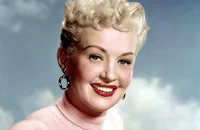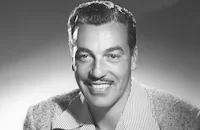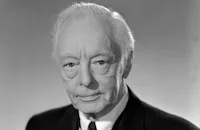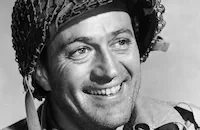That Lady in Ermine

Brief Synopsis
Cast & Crew
Ernst Lubitsch
Betty Grable
Douglas Fairbanks
Cesar Romero
Walter Abel
Reginald Gardiner
Film Details
Technical Specs

Synopsis
In 1861, Countess Angelina, who is presently ruling Bergamo in Southeastern Europe, marries Mario, a simple baron whom she has known since childhood. On their wedding night, the Bergamo castle, which holds a strategically important position on the road to Rome, is about to be taken over by Hungarian hussars, led by an imperious colonel. Mario, a somewhat cowardly scamp, leaves to join his regiment before the assault. At midnight, all the portrait subjects in the ancestral gallery come to life and step out of their frames, then ask one of their fellow subjects, Francesca, Angelina's great, great, great, great grandmother, to save the castle as she did three hundred years before. As she watches the colonel through a spyglass from the castle tower, Francesca becomes attracted to his wildness. That night, she smiles at him from inside the painting, and he is puzzled by her attire--an ermine coat and no shoes. The next day, Angelina, who resembles Francesca, welcomes the colonel with cold courtesy. Upon learning that her bridegroom has left, the colonel mocks his bravery and tries to flirt, but when he realizes that she respects marriage and is genuinely fearful for Mario's safety, he congratulates her on the marriage. Seeing that the colonel is lovesick, Luigi, the servant, relates Francesca's story: More than three hundred years earlier, the castle is surrounded by an enemy duke, a brutal tyrant. The duke plans to destroy the castle except for the countess' dog, whom he has come to love, so Alberto, the ineffectual count, offers his sword and then himself as a court jester. When that fails, Francesca, barefoot and in ermine, comes to the duke's tent with her dog. As Alberto sadly watches from the tower, the duke happily takes the dog into the tent, then, after Francesca follows, has his underling take the dog out. Later, the spent duke emerges from the tent's curtain and announces that the siege is over. Francesca leaves, and inside the tent, the duke falls onto the bed dead, a dagger sticking in his back. Back in the castle, Luigi tells the colonel that, according to rumor, she killed the duke because she was afraid of herself, as she, too, was falling in love. Disheartened, the colonel replies that at least the duke was not ignored. That night, as Angelina, bothered by the colonel, cannot sleep, Mario sneaks into her bedroom disguised as a gypsy. He runs off, however, when soldiers investigate his yelling from the room, and the colonel finds a gypsy earring in the rose bushes beneath her balcony. The next day, Mario, still in his gypsy costume, is captured, and the colonel, impressed by his musical ability, pays him to be his "personal gypsy." He soon realizes that Mario is Angelina's husband and offers to let him go if she will dine with him that night at nine, and even offers to provide a sharp knife she can use to kill him. Angelina does not come that evening, but Francesca later visits the colonel while he is sleeping, causing him to have a dream: As the clock goes back to nine, a carefree Angelina joins him and commands him to kiss her. As she embraces him, she removes a knife from a roasted pig and throws it at the clock's pendulum, stopping time. They acknowledge their love for each other, and dance and sing beautifully together. Then, as the portraits look on approvingly, she carries him up the stairs and they fly up and crash through the roof. The next day, the colonel awakens joyously, but realizes he has been dreaming when he sees the knife still in the pig and the clock ticking. Just then, Angelina arrives and declares that she tried unsuccessfully to reach Mario's general to plead for his life. After the colonel sets Mario free, he tells her about the dream. She is deeply touched when he states that, in the dream, she was magnificent and inspiring, "like no other woman," and before riding off with his men, he confesses he will always love her. She cries as she watches him from the balcony, and when Mario enters, sobs harder. She then assures her husband that she did nothing with the colonel and that she still believes in marriage. Sometime later, in another campaign, the colonel, whose motto used to be "another war, another love," is still disconsolate over Angelina. As the unhappy colonel sleeps, Angelina arrives, covers him and falls asleep in a nearby chair. He then dreams about the night in the castle, but awakens with a start when, in the dream, the knife pops out of the clock into her hand as they embrace, and she stabs him. When he awakens and sees Angelina, he washes his face with snow to make sure that she is really there. She then wakes up and tells him that the jealous Mario walked out on her. After kissing the colonel and proposing, Angelina reveals that she brought a priest with her, and he agrees to marry her. That night at midnight, the ancestors from the portraits dance and sing.

Director

Ernst Lubitsch
Cast

Betty Grable

Douglas Fairbanks

Cesar Romero

Walter Abel

Reginald Gardiner

Harry Davenport
Virginia Campbell

Whit Bissell
Edmund Macdonald
David Bond

Harry Cording
Belle Mitchell
Mary Bear
Jack George
John Parrish
Mayo Newhall
Lester Allen
Harry Carter
Thayer Roberts

Don Haggerty
Robert Karnes
Duke York
Ray Hyke
Jimmy Ames
Joe Haworth
Francis Pierlot
Crew
Harry Brand
Marie Brasselle
Esperanza Corona
Leonard Doss
Doris Drought
Tom Dudley
A. F. Erickson
Bunny Gardel
Roger Heman
Charles Henderson
Frederick Hollander
Renè Hubert
Natalie Kalmus
Arthur L. Kirbach
Maurice Lahmeyer
George Lane
Charles Lemaire
Thomas Little
Ernst Lubitsch
Bud Mautino
Roger Murphy
Alfred Newman
Ben Nye
Maurice De Packh
Hermes Pan
Edward Powell
Frank Prehoda
Otto Preminger
Otto Preminger
Samson Raphaelson
Leo Robin
Christian Von Schneidau
Walter M. Scott
Fred Sersen
Leon Shamroy
Fred Simpson
Dorothy Spencer
Herbert Spencer
J. Russell Spencer
Anthony Ugrin
Lyle Wheeler

Film Details
Technical Specs

Award Nominations
Best Song
Articles
That Lady in Ermine
Ernst Lubitsch was a living legend when he embarked on That Lady in Ermine in 1947. He had directed some of the most elegant and beloved comedies in the American cinema, from Trouble in Paradise (1932) and Design for Living (1933) to The Shop Around the Corner (1940) and Ninotchka (1939), and had even run Paramount Studio for a year. His distinctive mix of sophisticated comedy, slapstick, sexiness and innuendo was branded "the Lubitsch touch" throughout the industry. He brought that quality to That Lady in Ermine, a lightweight musical romance based on an operetta with an old Europe setting and a dramatis personae filled with witty royals, handsome soldiers, and wily servants.
Lubitsch first started developing an adaptation in 1943 as a vehicle for Irene Dunne and Charles Boyer. By 1947, 20th Century Fox studio head Darryl Zanuck thought the story would be a fine way to relaunch Betty Grable, a light musical comedienne and all-American girl famed for her million dollar legs, in a more sophisticated role. Grable was the studio's top box-office draw and Zanuck thought that working with a director of Lubitsch's caliber would add prestige to her popularity. He promoted the project to a lavish Technicolor production and gave Lubitsch the biggest budget of his career.
Zanuck wanted Cornel Wilde as her leading man but Lubitsch suggested instead the more dashing and witty Douglas Fairbanks, Jr. as the conquering Hungarian officer, who invades the little kingdom with his army on Francesca's wedding night. "If only I had known, I'd have delayed my invasion a few days," the proper, polite officer tells Francesca by way of apology. "Or at least a few hours." Cesar Romero completes the romantic triangle as the newlywed count who flees the invasion on his wedding night and sneaks back to the conquered castle disguised as a gypsy.
That Lady in Ermine was Lubitsch's first musical since The Merry Widow in 1934 and he threw himself into the project with renewed vigor. He coaxed longtime collaborator Samuel Raphaelson (screenwriter of Trouble in Paradise and The Shop Around the Corner, among many others) to transform his treatment into a screenplay and he spent weeks in preproduction and rehearsals with the actors. Lubitsch even wrote lyrics to some of the songs. "He was tripping over himself with ideas," recalled Fairbanks in later years. "During rehearsal he'd laugh with pleasure and sometimes he'd even ruin his own takes. And yes, he loved acting all the parts; he was very good, actually."
Though he was animated on the set, in reality he was in poor health. He was recovering from multiple heart attacks and kept the studio in the dark about his medical conditions as he began production. Raphaelson later confessed that Lubitsch's lack of vitality was evident in their writing sessions. A few weeks into shooting, he suffered another heart attack and he died on November 30, 1947, at the age of 55.
Otto Preminger, who had directed A Royal Scandal (1945), a project developed and produced by Lubitsch, took charge of completing the film, much to the frustration of the cast, who disliked the cold, controlling replacement. In addition to shooting the remaining scenes, Preminger reshot some of Lubitsch's completed footage ("because it was too subtle," according to Fairbanks) and cut other scenes, including two musical numbers, but gave Lubitsch sole credit as director when the film was released in 1948. The box-office paled next to Grable's more profitable Americana musicals like Mother Wore Tights (1947) and When My Baby Smiles At Me (1948) but it received a glowing notice from Bosley Crowther in The New York Times, who called the film "a bright and beguiling swatch of nonsense cut straight from the rich, gold-braided cloth of best-grade Graustarkian romance and done in a nimble, playful style."
Lubitsch's funeral was a Hollywood event. Hollywood's biggest star, directors, and studio executives attended, many of them as honorary pallbearers, and in a scene that could have come from a Lubitsch film, ended with one of the great Hollywood stories of all time. As directors Billy Wilder and William Wyler walked to their cars after the graveside ceremony, Wilder sighed: "Well, no more Lubitsch." "Worse than that," responded Wyler. "No more Lubitsch films."
Producer: Ernst Lubitsch
Director: Ernst Lubitsch; Otto Preminger (uncredited)
Screenplay: Samson Raphaelson (screenplay); Rudolph Schanzer, Ernst Welisch (operetta, uncredited)
Cinematography: Leon Shamroy
Art Direction: J. Russell Spencer, Lyle Wheeler
Music: Alfred Newman
Film Editing: Dorothy Spencer
Cast: Betty Grable (Francesca/Angelina), Douglas Fairbanks Jr. (Colonel Ladislas Karolyi Teglas/The Duke), Cesar Romero (Count Mario), Walter Abel (Major Horvath/Benvenuto), Reginald Gardiner (Alberto), Harry Davenport (Luigi), Virginia Campbell (Theresa), Whit Bissell (Giulio)
C-89m.
by Sean Axmaker
Sources:
"Betty Grable Plays 'That Lady in Ermine,' Lubitsch's Last Picture, at the Roxy," Bowsley Crowther. The New York Times, August 25, 1948.
"Ernst Lubitsch: Laughter in Paradise," Scott Eyman. Simon and Schuster, 1993.
"Ernst Lubitsch's American Comedy," William Paul. Columbia University Press, 1983.
"The Lubitsch Touch: A Critical Study," Herman G. Weinberg. Dover, 1977.
IMDb

That Lady in Ermine
Quotes
Trivia
Director Ernst Lubitsch died early in production; Otto Preminger completed the film.
Notes
The working title of this film was Lady in Ermine and This Is the Moment. Hollywood Reporter news items indicate that, during pre-production, the film's title was Lady in Ermine, but was changed to This Is the Moment at the start of principal photography. By the time of the picture's release, the title had been changed to That Lady in Ermine. According to information in the Twentieth Century-Fox Produced Scripts Collection in the UCLA Arts-Special Collections Library, although not mentioned in the onscreen credits, the screenplay was based on a German operetta, Die Frau im Hermelin, the screen rights to which the studio purchased in June 1942. The operetta also was the basis of a 1922 stage musical entitled Lady in Ermine, with additional music by Al Goodman and lyrics by Harry Graham and Cyrus Wood. Although the Produced Scripts Collection records do not specifically mention the 1922 musical as a source for the film, and none of the musical's songs were used in the film, it is possible that elements of the stage show's book were utilized. Studio records do indicate that Steven Vas did a literal translation of the operetta's book for the screen adaptation.
At the time of the operetta's purchase, Irene Dunne was announced as the film's star, and a few months later, Charles Boyer was announced as her co-star. According to modern sources, director Ernst Lubitsch also considered Jeanette MacDonald for the female lead. Modern sources note that, while the script was being written, Twentieth Century-Fox production chief Darryl F. Zanuck considered casting Cornel Wilde, Rex Harrison and Gene Tierney, in the role of "Angelina/Francesca," in the picture.
Studio information indicates that Ladislas Fodor wrote a first draft continuity, but it is not known if any of that material was used in the final film. According to the file on the film in the MPAA/PCA Collection at the AMPAS Library, in June 1947, the PCA deemed a draft of the screenplay "unacceptable" because "adultery and suspicion of adultery [were] treated for comedy without any compensating moral values." PCA director Joseph I. Breen suggested that, in order to counteract the moral negatives of the story, Angelina must be seen as wanting to preserve her marriage, and "Mario" must be the instigator of the break-up. Breen's suggestions were enacted, and in early October 1947, the final draft of the screenplay was approved by the PCA.
That Lady in Ermine was Lubitsch's first musical since the 1934 M-G-M production The Merry Widow. It also was his last film; he died from a heart attack on November 30, 1947, on a Sunday during a day off from production. Lubitsch had a history of heart trouble and, in 1944, had been forced to hand over direction of A Royal Scandal to Otto Preminger because of failing health . A few days after Lubitsch's death, Preminger took over production and direction of That Lady in Ermine with the stipulation that all screen credit should go to Lubitsch, "as a mark of respect and admiration for the departed master." It is not known how much footage in the completed film was actually directed by Preminger.
According to studio publicity, the ermine coat worn by Betty Grable in the film cost $28,000 and was made of 900 golden-white Russian ermine skins. Other films based on the German operetta include The Lady in Ermine, a 1927 First National silent, directed by James Flood and starring Corinne Griffith and Einar Hansen; and Bride of the Regiment, a 1930 First National musical, directed by John Francis Dillon, starring Vivienne Segal, Allan Prior and Walter Pidgeon (see AFI Catalog of Feature Films, 1921-30; F2.2932 and F2.0596). The 1927 film was also based on the 1922 Broadway play.














